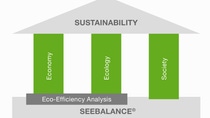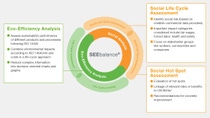Sustainability
SEEbalance®
Measuring sustainable development on a product level
SEEbalance® refers to the Socio-Eco-Efficiency Analysis developed by BASF firstly in 2005. The analysis is used to evaluate different product and process alternatives and allows for a direct comparison of these alternatives. The sustainability dimensions – economy, environment and society – are taken into consideration. SEEbalance® is an innovative tool that bundles various methods of analysis, allowing to assess not only the environmental impact and costs of products and processes but also the societal impacts thereof.

Design of the methodology in the context of academic research and external developments
The design of the methodology was the result of a cooperation between BASF and various academic research institutions including the Institute for Geography and Geoecology of Karlsruhe University, the Ökoinstitut e.V. and the University of Jena. The cooperation formed part of the “Sustainable Aromatics Chemistry” research project supported by the German Federal Ministry of Education and Research (BMBF). When BASF first introduced SEEbalance® in 2005, being able to show and assess all three pillars of sustainability in just one weighted result was seen as a novelty.
Since then, the methodology has continuously been further developed. As part of the improvement process, BASF paid close attention to external developments: just recently, the social dimension of the analysis has been updated. The optimization took place according to the latest insights and standards which BASF had for instance gained at the Roundtable for Product Social Metrics or at the World Business Council for Sustainable Development.

2 SDG: UN Sustainable Development Goal
Towards a holistic display of sustainability
In the new SEEbalance® methodology, the economic and ecological factors are measured with the “Eco-Efficiency Analysis”. In addition, SEEbalance® also considers relevant findings about the social impacts of products and process alternatives. Social criteria and objectives – such as education, health or working conditions – are becoming increasingly important which is why these factors are also addressed by the UN SDGs (Sustainable Development Goals).
For this reason, the tool for measuring the social pillar of sustainability has recently been expanded, reflecting these recent developments. The updated tool aims to undertake the complex translation of translating social aspects into values, numbers and information. After the update, economic and ecological factors still remain important components of the SEEbalance® methodology. In addition to the “Eco-Efficiency Analysis”, a “Social Analysis”, which measures social aspects in two seperate modules, is part of the methodology.
In both modules of the “Social Analysis,” the social conditions of workers, consumers and communities are analyzed and evaluated. The “Social Life Cycle Assessment” analyzes social data in a life-cycle approach using product information from data banks and companies along the entire value chain of a product. The module “Social Hot Spot Assessment” identifies specific social hotspots of each value chain in detail. The findings are linked to the UN SDGs (Sustainable Development Goals) to identify gabs and discuss improvement potentials.
The new SEEbalance® method was reviewed by three independent external partners in 2020 and can be applied in different fields of applications, predominantly in supporting strategies focusing on sustainability aspects, Procurement, Politics and Advocacy, Marketing as well as together with customers.
Example for a Social Analysis application
Together with the TU Dresden, the Social Analysis was applied in assessment of a new textile reinforced concrete alternative compared to the classical steel-reinforced concrete (SRC). One alternative in this study is the carbon concrete composite (CCC). CCC is hereby defined as a type of textile reinforced concrete, respectively cement-based carbon fiber reinforced composite using a fine-grained concrete and mesh-like textile reinforcements or carbon fiber rods.
The goal of the research project V2.10, lead by the TU Dresden and funded by the German Federal Ministry of Education and Research, refers to the latter by assessing the sustainability potential of building components made of innovative textile reinforced concrete. A life cycle sustainability assessment framework was conceptualized and applied to variants of sandwich wall systems made of carbon concrete composites and steel-reinforced concrete. Results indicate hotspots in technology and material choices that could be addressed by circular strategies, for example, refuse, reduce or recycling. Overall, one design variant made of carbon concrete composites is the best performing with respect to all dimensions of sustainability.
Overall, the classical steel-reinforced concrete has a higher aggregated social risk score of 6.8 as compared with 5.9 for the variant carbon concrete composite (CCC). That means CCC performs slightly better from a social sustainability perspective.
Sources:
Scope, C., Guenther, E., Muendecke, E., Schultze, K., Schuetz, J., Mielecke, T., Saling, P.; (2020), Aiming for life cycle sustainability assessment of cement‐based composites: a trend study for wall systems of carbon concrete, November 2020, Civil Engineering Design 2(5-6) DOI
Saling, P., Sustainability assessments of chemical products in Valdivia, S., Sonnemann, G. (Eds), Handbook on Life Cycle Sustainability Assessment, (2024), 279-289; Edward Elgar Publishing, Print ISBN: 9781800378643, eISBN: 9781800378650, DOI, DOI
Saling P., Alba-Perez A., Kölsch P., Grünenwald T.; (2020) Generation, Calculation and Interpretation of Social Impacts with the Social Analysis of SEEbalance®. In: Traverso M., Petti L., Zamagni A. (eds) Perspectives on Social LCA. SpringerBriefs in Environmental Science. Springer, Cham; DOI; ISBN 978-3-030-06564-5
de Beer, I.M; Goedkoop, M.J.; Saling, P.; Morris, D.; Florea, A.; Hettinger, A.L.; Indrane, D.; Visser, D.; Morao, A.; Musoke-Flores, E.; Schenker, U.; Collotta, M.; Van Parys, B.; Product Social Metrics Implementation Guide, version 1.0, Amersfoort, August 2019;

Results for the CCC alternative of the Social-LCA

Comparison of the aggregated results of the Social-LCA for the CCC and SRC alternatives
SEEbalance® fields of application
SEEbalance® supports decision makers in identifying the sustainability benefits and trade-offs along the value chain of products or processes.

For further information, please do not hesitate to contact us under seebalance@basf.com or visit our homepage www.basf.com/sustainability.
